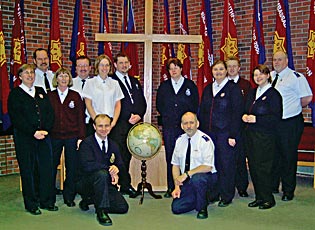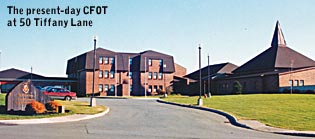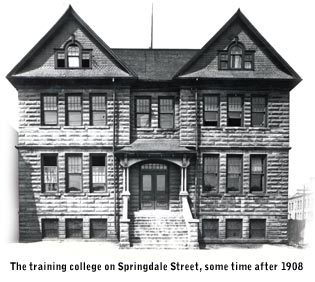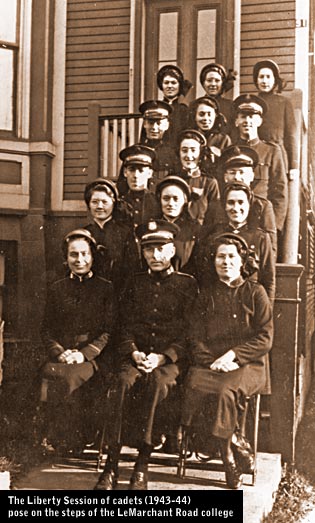 116 years of officer training comes to an end in Newfoundland and Labrador
116 years of officer training comes to an end in Newfoundland and Labrador
I walk quietly past the pictures of officers and cadets hanging on the corridor walls of the college for officer training in St. John's. A thousand faces look out at me. If they could speak, I wonder what those who have gone before would say about the history-making events now unfolding.
At the end of June, after 116 years, the last cadet will be commissioned from a Newfoundland training college. It will be time to move on. For more than a century, officers have been sent forth to minister in communities large and small throughout Newfoundland and Labrador, Canada, Bermuda and around the world.
It is understandable that the closure of the officer training college is being keenly felt by Newfoundland Salvationists. It is one more in a long series of changes that have taken place since Newfoundland joined Confederation in 1949. The railway has been replaced by a highway, oil rigs have replaced fishing boats, the capital has grown while some outports have disappeared. In The Salvation Army, the loss of denominational schools and the closure of the St. John's Grace Hospital have been difficult.
Yet there have been many positive changes, too. Newfoundlanders have risen to become world-class statesmen, artists and athletes, taking on leadership of Canada's Armed Forces and bringing home gold medals from the 2006 Winter Olympics. In the Army, church plants are seeing new growth, music and camping programs are being expanded, and many congregations are now operating out of new facilities as they focus more on community needs. Newfoundland officers have risen to top positions of Army leadership both in Canada and Bermuda and around the Army world.
 Moving Forward
Moving Forward
Commissioner M. Christine MacMillan, territorial commander, acknowledges the feelings of local Salvationists as they come to grips with the closure of the St. John's College for Officer Training (CFOT). At the same time she wants to encourage them to put the loss in perspective and not allow the circumstances to drag them into despair. 'We have not lost the ministry that the college has produced,' she writes, 'and we have not lost the call for young people of Newfoundland and Labrador to serve.'
Major Ray Rowe, divisional commander for Newfoundland and Labrador East, trained at 21 Adams Avenue from 1967 to 1969. 'We have been fortunate to have an officer training college for more than 100 years,' he admits. 'We should applaud our heritage, and thank God that we still have a training college in Winnipeg to equip men and women for Salvation Army ministry.'
Colonel Roy Bungay, divisional commander for Newfoundland and Labrador West, served for eight years as education officer at the St. John's CFOT. 'The distinction of having our own training colleges for over a century is something we can be proud of,' he writes. While admitting that the closure has not been easy to accept, he acknowledges that the goal of equipping every officer with a degree can best be accomplished by having the new Winnipeg CFOT in close proximity to William and Catherine Booth College, the prime provider of accredited ministry education.
As part of moving forward, Salvationists must celebrate all that has been accomplished over the years, recognizing that the lives of those who have gone before continue to influence succeeding generations today. This is certainly true of the officers who trained in this province over the past 116 years. Their accomplishments for the Kingdom of God and for the Army will live forever. Their ministry will be celebrated in ages to come as saints and angels gather to tell how the grace of God was shed abroad in many places through them.
Embracing the Future
Thankfully, God is still calling men and women to serve him as Salvation Army officers. This month, 13 cadets of the Visionaries Sessions will be commissioned as part of the historic congress marking the closure of the St. John's college.
While only five of these new officers are from Newfoundland and Labrador, it is worth mentioning that five more are already blazing the trail at the new territorial training college in Winnipeg. Among the 21 cadets of the Heralds of the Good News Session who will be commissioned in 2007 are Cadets Jocelyn Banfield from Garnish, Sheldon and Ashley Bungay from Corner Brook, and Mark and Nancy Braye, originally from St. John's Citadel but who entered training from Fort McMurray, Alta.
During this time of transition, it is perhaps also significant that the last principal of the St. John's CFOT, Major Ray Harris, trained in Toronto and the first principal of the Winnipeg CFOT, Major Sandra Rice, trained in St. John's. Each has experienced the loss of the facility in which they spent their formative years as cadets, and must now look to the future to see what new thing God is doing.
Reflecting on the historical events now unfolding, Major Harris says, 'This province's contribution to officer training is far from over. It has been my privilege in these three years to appreciate Newfoundland and Labrador's history more fully, to come to love its music and its people. And in my view this province is 're-inventing' itself in so many ways, including the way Salvationists will contribute to officer training. Educators understand that learning does not depend upon a residential facility, and Salvationists know that personal and institutional learning is part of our ongoing ministry, not simply two preparatory years of training. My personal conviction is that Newfoundland and Labrador still has a critical part to play in officer training, even without the facilities of 50 Tiffany Lane.'
Major Sandra Rice admits to having mixed emotions when she thinks about the closing of the college in St. John's. 'I do not always find change easy,' she says, 'yet I am amazed at the new opportunities that change provides. As I reflect on the present move and interact with cadets who are here (in Winnipeg) from across the country, I am reminded by their own experiences and discussions, how geography is not a major issue for them.'
Referring specifically to the Newfoundland cadets, Major Rice comments, 'It is clear to me they have made themselves available to the territory to go where they are needed. They are not shy about saying that for them this includes the opportunity to return to appointments in Newfoundland and Labrador.'
Was that a 'Hallelujah' I heard from somewhere overhead? I do believe that that 'great cloud of witnesses' is cheering. After all, the true pioneering spirit is the one that dares to go beyond the familiar, to break new ground, to venture into the unexplored future. It is not where one's ministry begins that matters, but how it is carried out.
________
Officer Training in Newfoundland and Labrador
Its History and Impact
Considering the province's relatively small population, The Salvation Army is incredibly well represented throughout the region. There are probably more Salvationists per capita in Newfoundland and Labrador than in any other place in the Army world.
In his book The Salvation Army in Newfoundland, historian Gordon Moyles tells how more than a third of Canada's Salvationists reside in or come from this unique province. Apart from the 40,000 who still make the island their home, about half that number are scattered throughout corps in Canada, with large concentrations in Ontario and Alberta. Similarly, about a third of all officers in Canada and Bermuda are from Newfoundland and Labrador, an indication of the tremendous impact this one province has had on the rest of the territory.
 In the Beginning
In the Beginning
In its early years in Newfoundland, The Salvation Army spread rapidly throughout the island. Not merely content to take advantage of a growing discontent with Methodism in the larger communities, the Army was committed to providing a spiritual ministry in small outports that that had never known one'places such as Little Bay, Harry's Harbour, Famish Cove, Jackson's Cove, Bay Bulls Arm, Triton, Nipper's Harbour and New Bay.
What enabled the Army to meet this gratifying demand was this very impressive statistic'in its first decade of ministry approximately one-fifth of its new converts offered themselves for officership. Not all were chosen, but official records show almost 250 Newfoundland young people who were trained and commissioned between 1887 and 1900.
The first cadets were trained quickly and in a very practical manner, simply by being assigned to a more experienced officer and learning by observing. After 1889 they would spend up to two months at a training garrison attached to one of the larger St. John's corps. From there they would be commissioned, often to one of the remote fishing villages dotting the coast and accessible only by boat. Moyles writes: 'Young and inexperienced, poorly educated, unsophisticated in the ways of theology or public service, but bred to hardship and filled with revivalist fervour, they were the only permanent preachers most outport people had ever known.'
It was largely these officers who were responsible for the phenomenal growth of the Army throughout rural Newfoundland. And in addition to looking after the corps, it was also expected that they would be the local school teacher as part of the denominational school system that existed up until 1969. Moyles comments: 'At this remote distance in time it is almost impossible to appreciate the dedication of those officers, or to visualize the hardships and sacrifice they endured.'
 First Training Home
First Training Home
In 1890, four years after the Army officially commenced in St. John's, the two main corps began training officers. Men cadets lived in a house on Dicks Square and trained at the No. 1 Corps, while women cadets trained at No. 2 Corps and resided at 29 Pennywell Road. The men's residence was moved to Gower Street in 1893, and the women were sent to Harbour Grace to train under the corps officers.
Following 1897, training continued at various locations in St. John's, until a permanent facility was built and opened in 1908 at the corner of Springdale and George Streets. The first full-time training principal was appointed in 1912. Cadets included those training to be schoolteachers, nurses and corps officers, with only the latter involved in Bible study.
In 1931, because of financial difficulties caused by the Great Depression, the training facility was closed. Training for women commenced again in 1937, and for men in 1938, although the college had to close again in 1941 because so many young people had gone off to war.
 The Post-War Years
The Post-War Years
In 1942, training recommenced at a new location'91 LeMarchant Road. The move was necessary because the original No. 1 Barracks on Springdale was being demolished to make room for the new Temple Corps.
In 1964, the brand new William Booth Memorial College for Officer Training at 21 Adams Avenue was opened, coinciding with the commencement of the two-year training program. A place filled with memories for many officers still serving today, this was replaced in 1984 by yet another facility at 50 Tiffany Lane.
Commencing in 2003, all cadets from the Canada and Bermuda Territory were trained in St. John's. Since that time the Toronto CFOT was officially closed in 2004 and cadets began training in Winnipeg in 2005. This month the last cadets will be commissioned from St. John's CFOT as part of the provincial congress taking place June 23-25.
________
Historical photographs courtesy of territorial archives
by Major Fred Ash
Director of Personnel, St. John's CFOT